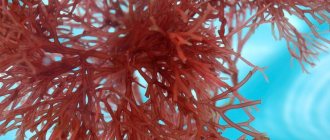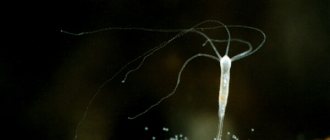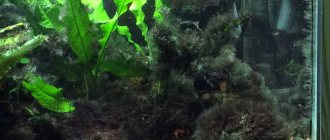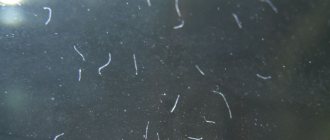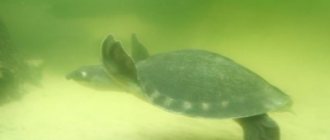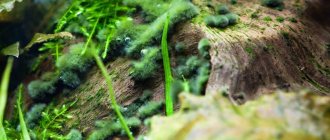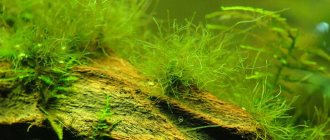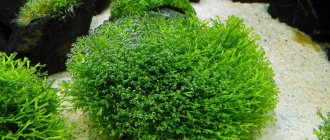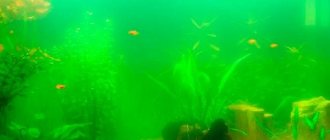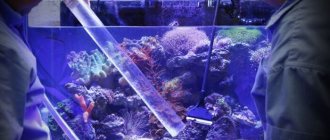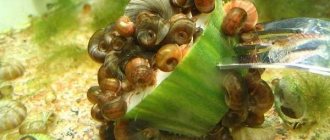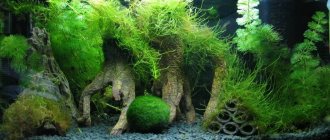Beginning aquarists call all plants that can be found in an aquarium algae. However, experienced aquarists will never confuse algae and aquarium plants. It costs them too much to control algae to make such a mistake. What's the difference, you ask? Algae are lower plants, without roots, leaves, or shoots. They grow quickly, aggressively and with their appearance significantly worsen the appearance of the aquarium, covering the walls and aquarium plants. Algae grows in aquariums, in salt water and in fresh water, and this means that the aquarium is alive. For an aquarist, the growth of algae is only a sign that something is wrong in the aquarium.
All aquariums have algae on sand and gravel, rocks and plants, walls and equipment. They are completely natural and part of the normal balance, unless they grow rapidly.
All that is required for a balanced aquarium is clear, well-mixed water and clean glass. I even advise not to clean all the walls of the aquarium, leaving the back one covered with fouling.
I have noticed that when algae is left to grow on the back wall or rocks, it absorbs nitrates and other waste products, thereby reducing the opportunities for algae to grow on the front and side walls of the aquarium. In addition, many catfish eat them (for example, Ancistrus).
Many aquarium inhabitants feed intensively on surfaces overgrown with algae. The cichlids of Lake Malawi are widely known as fish adapted to feeding on algae.
Examples of the type, pseudotropheus, are very characteristic. These fish have hard teeth that allow them to tear algae from rocks. Mollies look for clearings of algae and pluck them. In the marine environment, algae are an important part of the diet of sea urchins, sea worms and chitons.
For example, algae of the genus Aufwuchs (from German - growing on something), grow on hard substrates such as rocks, in both fresh and salt water. Algae, especially green algae and diatoms, are the main habitat for small crustaceans, rotifers, and protozoan life forms.
I stimulated algae growth in my cichlid to create a natural environment and got the right amount of filamentous algae and diatoms. Thus, depending on the fish species and habitat habitat, growing algae may even be desirable.
However, they often begin to multiply rapidly and worsen both the appearance and condition of the plants. And here begins the fight against algae, a phase that is familiar to many aquarists, especially those who prefer aquariums with plants.
Description
In reservoirs with an established biological environment, weeds are present in small quantities. It is worth worrying when faced with their rapid growth. Often a green coating appears on the walls of the aquarium, methods of combating which are discussed in a separate article. To combat lower vegetation in an aquarium, it is important to identify the type of algae. This way you are guaranteed to get rid of parasitic flora and not harm other inhabitants of the reservoir.
Planting vegetation
Another way to combat green pests is to plant fast-growing plants that take large amounts of nutrients from the water. As a result, the weeds do not have enough nutrition, and lower species die. Elodea in the aquarium, hygrophila, aquarium lemongrass, and hornwort will help eliminate green and purple growths in the tank.
Reasons for appearance
- Violation or absence of biobalance. If there is a high level of organic matter in the aquarium (rotted grass, uncollected grass, fish waste and leftover food), the weeds have many food sources. Excess organic matter occurs due to overcrowding, infrequent aquarium maintenance and overfeeding of fish.
- Excess or deficiency of phosphorus and nitrates. Higher flora cannot cope with excess fertilizer, so phosphates and nitrates are consumed by algae. And also the lack of nutrients creates a favorable environment for weeds.
- Excess or lack of light. With long daylight hours, lower greenery absorbs excess light, and the plants weaken. The lack of light, in turn, creates conditions for the proliferation of some weed species.
- Incorrect lamp spectrum. Higher flora needs light in the blue and red spectrum. Weeds love the warm yellow light that incandescent lights and sunlight provide.
Xenococus
These algae live in almost every aquarium, but begin to actively reproduce only when there is an imbalance in the system. They look like green dots that merge into a continuous coating, and slow-growing specimens - Anubias, Staurogyne, etc. - suffer most from xenococcus.
How to fight
- algae must be removed from surfaces using scrapers or improvised means (toothbrush, etc.);
- Gyrinocheilus or Otocinclus fish can be used as natural enemies;
- Aquayer Algaecide + CO2 is recognized as an effective remedy - the drug needs to be treated with a syringe on contaminated surfaces, turning off the filters for half an hour;
- Tropical Algin (1 ml per 10 liters of water) and JBL Algol (100 ml bottle of product is designed to treat 400 liters of water) give a good effect;
- in an infected aquarium, it is recommended to plant fast-growing plants (hornwort, vallisneria, hygrophila) to regulate excess nutrients, which causes the appearance of xenococus.
After cleaning the aquarium, you need to adjust the lighting - red and “cold” lamps should predominate, and yellow light increases the likelihood of xenococcus occurring.
Brown or diatoms
Brown algae appears as plaque on the walls of the aquarium, leaves and soil. Harmless to flora and fauna. They often appear in the aquarium of beginners due to unstable biobalance and lack of light. Aquarium algae thrives in hard water with a pH above 7.5. To prevent growth, replace the bulb with a more powerful one or add another light source. If you don’t wipe off the brown plaque, it will form a thick layer that is difficult to deal with.
Common features
Algae appear on their own based on biological processes occurring in the container. Often their occurrence is influenced by the acquisition of new underwater vegetation or feeding the fish with live food.
Algae are diverse:
• by location – free-floating or attached to surfaces; • by color – green, red, black, blue, pink, purple; • in shape – fluffy tuft, mucous coating, spread carpet; • by growth method – filamentous, branching, layered, flat; • in size - from those that can only be seen under a microscope, to 10 meters in length (in the wild).
What distinguishes algae from underwater plants is that they do not have distinct leaves, stems or rhizomes.
Red algae or black algae
They grow in tufts of gray, purple or reddish color, about 5 mm high. Also known as scarlets. They grow on all surfaces, in salt and fresh water. Purples are difficult to remove. They love hard water with strong currents. Preparations with glutaraldehyde are effective against them in combination with weekly water changes of up to 50% and thorough cleaning.
Vietnamese
The species is also called "stag antlers" because of the dark-colored branching tufts. Appears due to dead organic matter.
Black beard
Grows in black tufts. “Beard” is often confused with “flip-flop”, which is not a serious mistake, because the methods for getting rid of parasitic greenery are identical. If you notice that dark hairs have appeared on the plants in your aquarium, check out this article on methods to combat blackbeard.
Fighting algae in an aquarium with drugs
You knew what to do to prevent algae growth. But what to do if they are already growing in full force in the home pond and have already attacked almost every pebble and every corner?
Today, the best way to combat an algae outbreak is with special substances called algaecides. But don’t use drugs thoughtlessly! It is very important to carefully study the instructions, as some types of algaecides can be very dangerous to aquatic life.
Let us designate drugs that are not recommended for use.
- Substances containing copper sulfate are extremely dangerous for sensitive fish and pinnate plants, as well as for all invertebrate creatures.
- Preparations based on glutaraldehyde have not been included in studies aimed at identifying negative effects on aquarists and the inhabitants of their aquariums after use. Using this type of product involves certain risks!
The safest of all are drugs based on minolinuron.
Greens
The group of green lower flora unites about 20 thousand species of unicellular and multicellular plants. Greenery inhabits mainly fresh water bodies.
Xenococus
Externally, xenococus appears as green dots on glass, forming a coating. Appears in densely planted herbal gardens and in half-empty aquariums. Causes: excess light and low carbon dioxide levels.
What it is?
These are the lowest representatives of the underwater world. Individual microorganisms living in an aquatic environment. Algae appear and multiply beyond the owner's wishes. Moreover, an excess of green “parasites” can suffocate everything under water. This will eventually turn into a real nightmare.
filamentous
Filament appears when there is a large amount of iron and a lack of phosphorus, which plays an important role in nutrition. Grows in thin interlacing threads. Easily removed mechanically.
Rhizoclonium
The light green weed looks like light cotton wool. Appears in aquariums with an unknown nitrogen cycle. Disappears after biobalance is established.
Spirogyra
It consists of fragile and slimy threads. It is difficult to get rid of algae as it grows at a high rate in the aquarium. The reason for growth is excess light and lack of nutrition. Turning off the lights in combination with introducing algae-eating fish and adding medications helps.
Cladophora
Weed with short filaments. It grows with weak filtration in stagnant water, as well as with a lack of carbon dioxide.
Settlement of algae eaters
A pond that has been invaded by green pests can be saved by populating the container with algae-eating fish. Algae in an aquarium - how to fight it with the help of pets:
- Siamese algae eater - feeds on filamentous and brown algae, and xenococus. On rare occasions, it absorbs a Vietnamese woman and a black beard.
- Malawian cichlids - will help destroy part of the black beard, but they can also feast on higher plants.
- Catfish – happily feed on brown and green algae.
- Snails (ampularia, coils, nerets) - absorb filamentous and diatoms.
- Amano shrimp - will help eliminate thread in the aquarium.
Prevention
- Use live plants instead of artificial ones. Plant more greenery whenever possible.
- Add fertilizer after testing nutrient concentrations. Calculate your dosage. In aquariums with moderate lighting and a small number of plants, there is no need for fertilizers.
- If you notice rapid algae growth, begin eliminating the problem as early as possible.
- Do not leave the aquarium without equipment for a long time; the water must be constantly filtered and saturated with oxygen.
- Turn on the lights for no more than 8–10 hours a day.
- If you use fluorescent lamps, change them once a year. The shade of light becomes yellow over time - favorable for algae.
- Treat plants before planting. This will prevent algae from being introduced into the aquarium, and will also protect against parasites and snails. You can treat the greens in a solution of chlorine, hydrogen peroxide, or a slightly pink solution of potassium permanganate for a couple of minutes.
- If you are treating fish in a community aquarium, change the water more often and increase aeration. Medicines affect the biological environment and can lead to an algae outbreak.
- Keep a fish in your aquarium that eats algae.
- Clean weekly. Siphon the soil and change the water. Clean your glass windows every couple of weeks.
- Don't overfeed your fish.
- Avoid overcrowding the aquarium.
Not all lower greens are undesirable in the aquarium. There are useful representatives, for example, nitella, which filters water and decorates the aquarium.
Previous
DiseasesInstructions for the use of malachite greens
Next
Diseases20 common problems indicating guppy diseases
How to disinfect purchased plants
Along with quarantining new fish, disinfecting plants is a good practice. This can be done using bleach (sodium hypochloride, bleach), a liquid used to clean bathtubs and toilets. A 5% bleach solution is diluted in a ratio of 1:20 with water and immerse the plants for a couple of minutes. Then they must be thoroughly rinsed with running water. Some plants (especially long-stemmed ones with soft leaves - elodea, cabomba) do not tolerate this procedure well - so the time must be reduced (or not applied). This procedure does not destroy some types of algae (for example, blue-green ones - but they are noticeable immediately when purchasing the plant). Black beard is destroyed by such a bath. This procedure can be used periobically - for example, to remove black beard from Anubias, which is usually its first victim. Anubias carries out the procedure without problems.
You can also use potassium permanganate and hydrogen peroxide instead of bleach.
Why do they appear?
Some parasitic plants arise due to abundant light, others begin to grow due to an abundant amount of nutritional components.
The main causes of algae:
- Too many ornamental plants . They gradually clog each other, as a result of which algae can develop. However, at the same time, precisely because of the large number of plants, algae will not be able to develop too actively.
- Weak filtration or its complete absence . Particles of food and organic matter will accumulate in the soil, creating a favorable environment for the development of algae.
- Lighting – it all depends on the type of algae. Lighting may be insufficient or, conversely, in excess.
- A large number of fish . The more aquarium inhabitants, the greater the amount of nitrates and waste they leave behind. Consequently, the substances do not have time to be fully absorbed by plants, which is why algae are highly likely to form.
- Irregular cleaning of the tank . The dirtier the water and soil, the faster algae will appear in it.
General classification
Greens
This group includes the least developed representatives. The bulk of species are represented by solitary and colonial unicellular organisms; some multicellular organisms have a primitive structure - a “thallus”.
Currently, this department is considered the most widespread and most studied. A definite number is still unknown: new species are discovered every year! According to rough estimates, there are from 13 to 20 thousand green algae.
They live in all corners of the globe. They are eaten and used as bioindicators of the state of the environment. A number of genera are pests. The department is characterized by all kinds of reproduction and development cycles.
Brown
They are the most developed of all leaders. They are characterized by multicellularity, patterns of stage changes, and developed sexual and vegetative reproduction. Their body most closely resembles plant tissue. Most often they live in sea water at shallow depths - up to 40-100 meters. They occupy an important place in the aquatic ecosystems of the ocean.
Many species are protected, especially those living in the Galapagos Islands. They are used as food in many countries of East Asia, and they are no less important for science - it was on brown algae that humanity learned to sequence the genome.
Reds
The smallest group. Most species live in sea water, only a few live in fresh water bodies and soil. These algae can produce chlorophyll only at shallow depths, so they do not settle deeper than 50 meters. They are typical representatives of the bottom (benthic) vegetation of the coasts. There are approximately 7,500 species.
Agar-agar is made from them. They are the most demanding algae, so they are quite difficult to grow under artificial conditions. The oldest fossil found to date is a specimen of red algae, mined from rock in Canada.
Blue-green
Otherwise they are called Cyanobacteria. It is a mistake to call these creatures algae - they belong to ordinary bacteria capable of photosynthesis and releasing large amounts of oxygen. They are closest to ancient proto-organisms that went extinct billions of years ago. They can have different shapes, types of development and methods of reproduction. They are united only by the absence of flagella and the presence of a protective mucous membrane.
In aquariums and natural reservoirs, such bacteria are parasites that can lead to the death of fish. Normally, there are few cyanobacteria, but during environmental disasters (the application of fertilizers and pesticides), they multiply so actively that they produce substances that are fatally toxic to all aquatic animals.
Biological balance
Achieving complete biobalance is difficult, but possible. Normally, a reservoir, like a large natural reservoir, must maintain the circulation of substances. All dead remains must be broken down by beneficial bacteria and reduced to substances that can be consumed by plants, then produce energy through photosynthesis and again produce biological matter - most often starch and saccharides. Next, the fish eat the plants, digest them, build their bodies from amino acids, produce waste, and the process begins again.
Nitrifying bacteria are responsible for this balance. We will not fully describe the processes produced by these microorganisms: it is so complex that it deserves a whole series of articles. In nature, everything is harmonious, so the balance is established by itself, our task is just not to disturb it inadvertently or intentionally.
